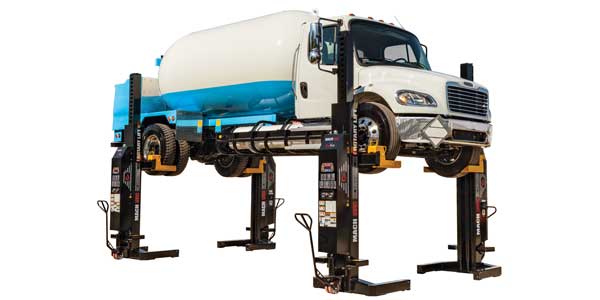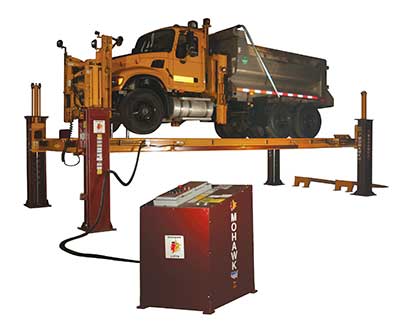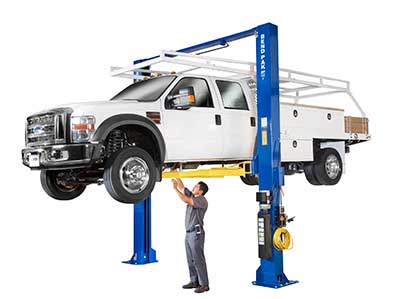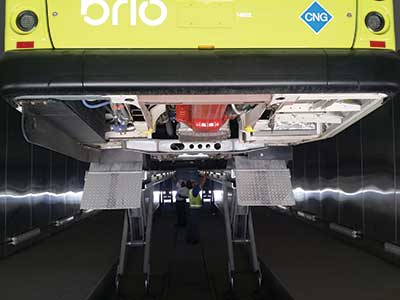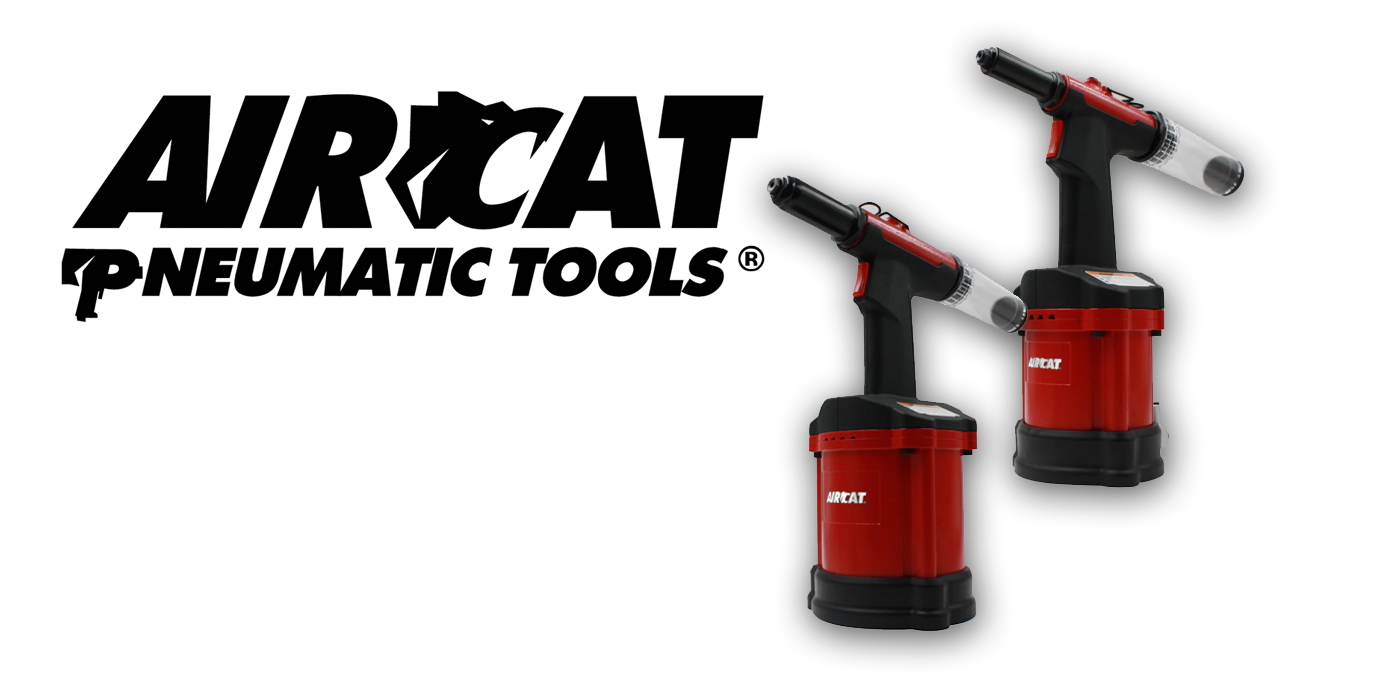“Before purchasing a lift, fleet managers need to take into consideration what they want to lift,” advises Steve Perlstein, marketing manager for Mohawk Lifts. “They also need to make sure all of the options are certified and correctly rated for the intended capacity. Some common lift issues are related to overlooking safety, which may include overloading the lift beyond the capacity for which it is rated or not lowering the lift onto the mechanical locks as recommended by the Automotive Lift Institute (ALI) best practices.”
ALI is a trade association of North American-based lift manufacturers that’s dedicated to the safe design, construction, installation, service and inspection of vehicle lifts. It sponsors several national lift safety standards and offers third-party certification programs for lifts and lift inspectors.
Before purchasing, Mohawk suggests you determine if the lift and its options (rolling jacks, adapters etc.) are ALI certified. As stated on the ALI website, using a non-certified option on a certified lift voids the lift’s certification. You should check the warranty and also ask what equipment is included and what has to be purchased separately (i.e. necessary truck adapters). Check the specs as they relate to your facility; for example, will the lift fit in your garage; do you have enough concrete, ceiling height, etc.?
“Weight-related safety infractions may be avoided by using a weight gauge,” Perlstein continues. “The gauge shows the total weight of the vehicle on the lift. The weight gauge also visually verifies that the lift has been lowered onto the mechanical locks when it reads ‘0.’ The manufacturer of the lift must make the weight gauge so its correctly calibrated to the cylinder size.”
Productivity can be can be enhanced by choosing the right lift. As an example, take the two types of mobile column lifts: screw drive or hydraulic drive. While a screw-drive lift takes six minutes for a full up/down cycle, hydraulic mobile column lifts take as little as two minutes to complete a full cycle. If a technician raises and lowers the lift four times per day over 200 days a year, there is a 54-hour time savings by using the hydraulic mobile lift. Now multiply this over five years. What would your shop do with an extra 270 hours of productive repair time?
Drive-on lifts, like four-posts and parallelograms, allow the technician to drive onto the lift and immediately start working on the vehicle without having to position the forks or swing arms (as would have to be done with mobile columns and two-post lifts). Four-post or parallelograms are also available with track lights, which give technicians a clear view under the vehicle to see potential problems. This option not only benefits the techs to help them do their jobs better, but reduces the potential for a vehicle leaving the shop with unseen issues and having future disruptions in service.
Mohawk manufactures a complete line of surface-mounted two-post, frame-engaging lifts in capacity ranges from 7,000 to 30,000 lbs. All two-post lifts offer a 25-year structural warranty. The company’s four-post drive-on lifts are offered from 19,000 to 120,000 lb. capacities with track lengths ranging from 13 to 60 ft. to service a full tractor-trailer. The parallelogram lifts range from capacities of 36,000 to 100,000 lbs. in surface or flush-mount design with track lengths from 26 to 48 ft. long.
Always be safe
“Safety is paramount when lifting vehicles of any size,” BendPak/Ranger’s Max Glassburg says. “Of course, there is always a need for increased safety awareness when lifting heavy-duty fleet vehicles. With either four-post or two-post lift types, the first concern is whether your lift can support the vehicle. That’s the weight capacity. Some less-experienced technician may mistakenly think that a 16,000-lb. vehicle will always be safe to lift on an 18,000-lb. capacity lift. However, since the front-to-rear weight distribution is rarely, if ever, 50/50 on fleet trucks, it’s easier than you may think to overload part of your lift, especially as vehicles approach the weight capacity of the lift. Unfortunately, these same folks often blame the lift when things go awry. Knowing the per-arm weight capacity on a two-post is crucial, as is knowing the front and rear capacities on a four-post.”
Another big safety issue is related to the lifting points of vehicles, which comes into play with two-post and other frame-engaging lifts. “Those manufacturer-recommended lifting points on a vehicle aren’t optional,” Glassburg stresses. “They’re located to keep the vehicle’s center of gravity between the lift arms.”
ALI produces an annual “Vehicle Lifting Points for Frame-Engaging Lifts” quick-reference manual (commonly called the “Lifting Points Guide”) that outlines OEM-recommended lifting points for the last 25 years of domestic and imported cars and light trucks. The 2017 edition now includes a “Safe Lifting Suggestions” section providing additional guidance.
“We have other safety features that are shared by our four-post and two-post lifts,” Glassburg adds. “The cable sheaves we install in both lift types are absolutely massive. Well-lubricated cables run over this wide surface area, which reduces friction and cable fraying, the number one cause of cable damage.”
Suited to the task
Vehicle lifts need to be suited to the task and enhance safety for technicians. “Truck fleet technicians make their living indoors in a difficult, somewhat dark shop environment,” says Doug Spiller, heavy-duty product manager for Rotary Lift. “They often handle dirty and greasy equipment, lift heavy parts and tools, and stand or lie in uncomfortable positions. Many shops have technicians working from their backs and on creepers. These conditions can expose technicians to knee issues, back strains, hand pinches and knuckle busting as they work in awkward positions or are constantly transitioning from prone to standing.”
Vehicle lifts can address all of these safety issues by simply moving the vehicle to an ergonomic position and providing optional lighting under the vehicle. “Wheel lifts, productivity jacks and transmission jacks can address heavy lifting and bending issues as well,” Spiller says. “Using vehicle lifts and jacks can represent a fundamentally different and better way to perform heavy-duty vehicle repairs and maintenance. One of our customers documented a reduction in soft tissue injuries by simply changing how their employees work, moving from pits and creepers to mobile column lifts.”
When transitioning to vehicle lifts, it’s important for shop managers to make sure technicians are well versed in a lift’s standard operating and safety procedures.
“For example,” Spiller begins, “most lifts are designed to be lowered onto their load-holding devices/mechanical locks before any vehicle service is performed. Rotary Lift’s LockLight provides instant visual confirmation that lifts are on their locks. It is available on many lifts as either optional or standard equipment.
“Visibility is also a safety concern,” he adds. “Vehicle lifts get heavy-duty vehicles up in the air, which in itself usually improves technician visibility. But to really shine a light on even hard to reach problem areas, Rotary Lift Tech Light series offers several options that can be adapted to meet a variety of service bay needs. These versatile lights are supplied with magnetic clips for precise positioning [no drilling necessary].
Rotary Lift offers all of the lift types commonly used in fleet maintenance facilities: in-ground lifts, mobile column lifts, four-post lifts, two-post lifts, scissor lifts, platform lifts and parallelogram lifts.
Meeting the challenges
“At Stertil-Koni, safety is always mission number one,” says Peter Bowers, technical sales manager at Stertil-Koni. “We recognize that the needs are demanding for fleet maintenance facilities, and the stakes are high when operating heavy equipment, maintaining and servicing professional fleets, and ensuring the well-being and efficiency of shop technicians working directly underneath large vehicles. In short, it can make for a challenging workplace. That’s why we focus on safety, reducing potential hazards on the shop floor while increasing productivity.”
In addition, Stertil-Koni advocates for fleets to choose lifts that are certified by ALI.
“Our lifts are engineered with mechanical locking systems for added safety,” Bowers adds. “For example, mobile column lift locking systems start at just five inches and continue up the entire height of the lift every 1 3/8th inches. In addition, each Stertil-Koni lift is fitted with an electronic synchronization system to ensure safe and level lifting—particularly important in cases where vehicle weight distribution is unequal, such as sweepers, mixers, fire trucks and other large vehicles.
Bower adds that the operating controls should be secure and informational. “Stertil-Koni mobile column lifts, for example, feature a touch-screen ebright Smart Control System, engineered to provide greater control of the vehicle lift in a built-in electronic notepad-style delivery system, all at the fingertips of the shop technicians. This approach is being expanded to our entire portfolio of lifting systems.”
Certification
To ensure that a lift meets local and national codes, shops should purchase only lifts that wear the (ALI) Gold Label demonstrating that the lift has been third-party tested and certified to meet industry safety and performance standards.
According to Bob O’Gorman, president of ALI, fleet maintenance operators should keep three things in mind regarding vehicle lifts:
- Only buy lifts that wear the gold ALI certification label indicating that they have been third-party tested and certified to conform with the American National Safety Standard ANSI/ALI ALCTV (current edition) Safety Requirements for the Construction, Testing and Validation of Automotive Lifts. This is required by the International Building Code, the building code in use or adopted by all 50 states. “To put it as simply as possible, If you’re installing a vehicle lift in an area covered by the International Building Code, you must choose an ALI-certified lift,” O’Gorman says. A directory of certified lifts is available on the ALI website.
- Be sure everyone using a lift has been trained on its proper operation and maintenance, and document this training.
- Have your lifts inspected by a qualified lift inspector at least annually. This safety requirement is outlined in the American National Safety Standard covering vehicle lift operation, inspection and maintenance, ANSI/ALI ALOIM (current edition).
Regular lift inspections can identify issues before they grow into larger problems. The ALI Lift Inspector Certification Program provides third-party qualification of vehicle lift inspectors and certifies those who demonstrate that they can inspect lifts in accordance with the ANSI standard. To make it easy to find a local ALI Certified Lift Inspector, ALI offers a searchable directory on its website.

